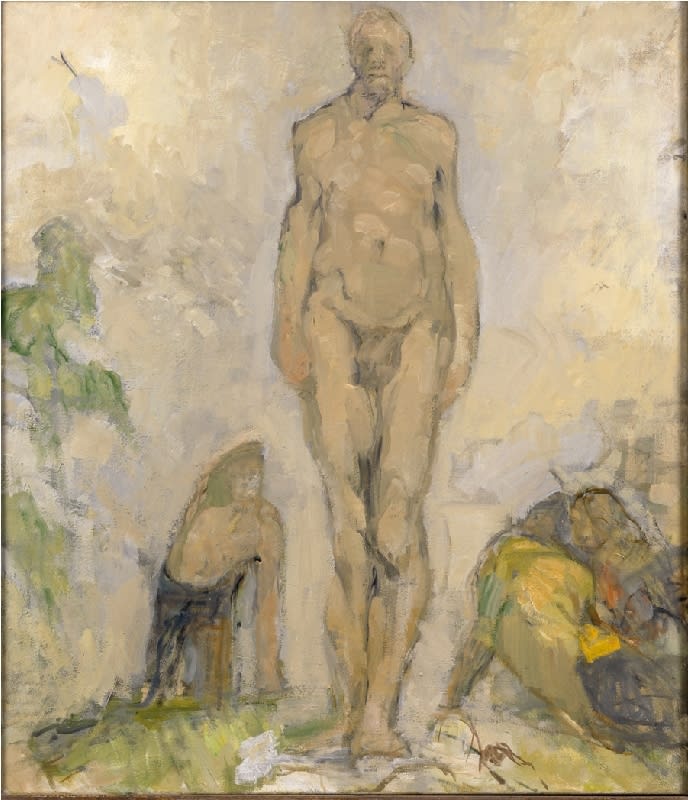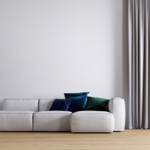Robert Medley 1905-1994
Self Portrait after Watteau (Gilles au Nu), 1980
Oil on canvas
101.5 x 88.5 cms
39 15/16 x 34 13/16 ins
39 15/16 x 34 13/16 ins
2542
Sold
Medley's self portraits inspired byWatteau's Gilles are his greatest late works,a culmination of his lifelong engagement with the art of the past and a reflection on his own mortality. Medley's...
Medley's self portraits inspired byWatteau's Gilles are his greatest late works,a culmination of his lifelong engagement with the art of the past and a reflection on his own mortality.
Medley's greatest paintings not only engage with the art of his contemporaries but also resonate with echoes of the greatest art of the past as in the grandeur of Pieta. Medley, himself,was diffident about his achievements but the testimonials of John Berger,Maggi Hambling,David Hockney,Kitaj and admiration of Francis Bacon, Prunella Clough and Lucian Freud all confirm his influence and centrality to British cultural life over a remarkable span of the twentieth century. For many, including Kitaj,'his masterpiece was probably his painting of Gilles'. (Kitaj, interview with Andrew Lambirth, 2005). Medley painted just three self-portraits after Watteau's Gilles, the present work and two others that are in Private Collections.He also painted a fourth, much looser,work that is reproduced here for the first time, and harks back to his paintings of the 1960s. In these brave late self portraits the aged artist appears to stare death in the face in a moving embodiment of the ageing process.Their impact was immediate, as Norman Rosenthal recalls: 'It must have been about 1980 when I went to the studio and found an astonishing composition - a painting of the artist standing naked in a modern landscape - trees replaced by power stations, seemingly half-naked, dead Dante-like figures rising from behind. It is a painting that is based principally onWatteau's masterpiece Gilles in the Louvre. It is also a homage to Cézanne's Bathers ... I saw it as a masterpiece of Robert's - self-confessional and full of enormous culture. I also felt the need, if possible, for the painting to be part of my own life.We agreed a price, as well as installment terms. Robert thus still looks out at me every day like the judge ofAuden's The Hidden Land...Not much later, Lucian Freud came, for whatever reason, to my small flat - then close to the RoyalAcademy - where he saw Gilles. In my perhaps subjective memory he stared with uncommon intensity at the painting for a long stretch of time.Not long after that his own nude self-portrait appeared, as well as many other male nudes.' (Norman Rosenthal in Robert Medley:a centenary tribute, James Hyman Gallery, London, 2005).
Medley's greatest paintings not only engage with the art of his contemporaries but also resonate with echoes of the greatest art of the past as in the grandeur of Pieta. Medley, himself,was diffident about his achievements but the testimonials of John Berger,Maggi Hambling,David Hockney,Kitaj and admiration of Francis Bacon, Prunella Clough and Lucian Freud all confirm his influence and centrality to British cultural life over a remarkable span of the twentieth century. For many, including Kitaj,'his masterpiece was probably his painting of Gilles'. (Kitaj, interview with Andrew Lambirth, 2005). Medley painted just three self-portraits after Watteau's Gilles, the present work and two others that are in Private Collections.He also painted a fourth, much looser,work that is reproduced here for the first time, and harks back to his paintings of the 1960s. In these brave late self portraits the aged artist appears to stare death in the face in a moving embodiment of the ageing process.Their impact was immediate, as Norman Rosenthal recalls: 'It must have been about 1980 when I went to the studio and found an astonishing composition - a painting of the artist standing naked in a modern landscape - trees replaced by power stations, seemingly half-naked, dead Dante-like figures rising from behind. It is a painting that is based principally onWatteau's masterpiece Gilles in the Louvre. It is also a homage to Cézanne's Bathers ... I saw it as a masterpiece of Robert's - self-confessional and full of enormous culture. I also felt the need, if possible, for the painting to be part of my own life.We agreed a price, as well as installment terms. Robert thus still looks out at me every day like the judge ofAuden's The Hidden Land...Not much later, Lucian Freud came, for whatever reason, to my small flat - then close to the RoyalAcademy - where he saw Gilles. In my perhaps subjective memory he stared with uncommon intensity at the painting for a long stretch of time.Not long after that his own nude self-portrait appeared, as well as many other male nudes.' (Norman Rosenthal in Robert Medley:a centenary tribute, James Hyman Gallery, London, 2005).
Provenance
The Artist's EstatePrivate Collection
Exhibitions
The Naked Portrait, Scottish National Portrait Gallery, Edinburgh, 2007Literature
The Naked Portrait, Scottish National Portrait Gallery, Edinburgh, 2007(discussed p.83 and illustrated full page colour p.85)


